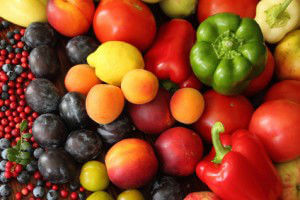
We all know that eating plenty of fruits and vegetables is essential to good health. All fruits and veggies contain essential vitamins, minerals, antioxidants and other nutrients. However, some of these nutrients are color-specific.
Dr. Lorelei DiSogra of the National Cancer Institute explains that it is important to eat an assortment of different colors of fruits and vegetables every day. This is because there are thousands of phytochemicals found in plants, and some only exist in certain varieties.
The following is a general overview of the main nutritional gems found in each fruit and vegetable listed by color.
Red and Pink
Fruits and vegetables that are red, or bright pink, in color contain the phytochemical lycopene, as well as anthocyanins. Lycopene has been linked to reducing the risk of various cancers, and has been especially studied in regards to preventing prostate cancer. Foods rich in lycopene include tomatoes, guava, watermelon and pink grapefruit.
Anthocyanins are potent antioxidants which are associated with lowering blood pressure, boosting the health of the heart and cardiovascular system, and protecting against diabetes. Red berries, including raspberries, red cherries, cranberries and strawberries, red cabbage, red apples, red onions and kidney beans and other red beans are good sources of anthocyanins.
Red grapes, especially Spanish grapes, contain resveratrol, a compound that has been linked to anti-aging properties.
Orange and Yellow
Orange and yellow fruits and vegetables are high in vitamin C, which is vital to optimal immune system function. They also contain beta carotene, a phytochemical that has been linked to reducing the risk of heart disease and cancer. It also boosts the immune system, and helps maintain healthy eyesight.
Mangoes, pumpkins, peaches, apricots, cantaloupe, sweet potatoes and butternut squash all contain high levels of beta carotene.
Fruits and veggies with this color profile, especially citrus fruits, are a great source of bioflavonoids. Bioflavonoids interact with vitamin C to promote the health of teeth, bones and skin. They also aid in wound healing and are implicated in lowering the risk of heart attacks.
Papaya, pears, pineapple, yellow peppers and citrus fruits including lemons, oranges, tangerines, and grapefruit contain bioflavonoids.
Green
Green vegetables contain the antioxidant lutein. Lutein is connected to supporting optimal vision, healthy skin and interfering with the thickening of arteries, and lessening the risk of cardiovascular disease. For this reason, lutein is an important nutrient for heart health. Great veggie choices for lutein content include broccoli, green beans, cucumbers, artichokes, green peppers, okra and broccoli.
Dark, leafy greens have their own set of nutritional properties. They are chock full of minerals such as magnesium, which is essential for energy production in the cells, calcium, which supports bone and nervous system health, potassium, which is key for healthy growth, protein synthesis and muscle building, and manganese, which supports brain health and keeps the mitochondria, the energy center of cells, working properly.
Leafy greens are also full of B-vitamins, including folate, which is important to a healthy heart. There are many types of leafy greens; some common varieties include kale (a superfood in its own right), spinach, mustard greens, collard greens and arugula.
Blue and Purple
Like red and orange fruits and vegetables, blue and purple fruits contain anthocyanins. They are also high in phenolic acids, including flavonoids, hydroxycinnamic acids and hydroxybenzoic acid. Phenolic acids function by preventing free radical damage in the body and protecting the cells throughout various organ systems. This protection leads to a lessened risk of a variety of chronic illnesses.
Some delicious blue and purple fruits include blueberries, purple grapes, blackberries, elderberries, eggplant, plums and black currants.
Blueberries and blackberries have recently been associated with anti-aging properties, including improving memory of individuals over age 50. Blueberries are also a good source of resveratrol, containing nearly as much of the compound as red grapes.
 White
White
White vegetables in the onion family contain the phytochemical allicin. Allicin is linked to lowering blood pressure, preventing heart disease and cancer and increasing the ability of the immune system to fight infections, thanks to antibacterial, antiviral and antifungal properties. It also possesses potent detoxification properties.
Veggies that contain allicin include onions, garlic, leeks and chives. The detoxification and immune-stimulating properties of garlic are largely thanks to the allicin that it contains.
When choosing fruits and vegetables of all colors, remember to choose organic, or, grow your own. Organically-grown produce often has higher levels of nutrients than commercially-grown counterparts, and is not doused in pesticides and herbicides. These factors combined give you the absolute best chance for optimal health.
-The Alternative Daily
Sources:
http://www.marksdailyapple.com/why-you-should-eat-leafy-greens/#axzz2gOoSP5r2
http://unclewileys.com/index.php/content/view/42/40/
http://www.ahealthiermichigan.org/2011/03/22/using-color-as-a-guide-to-a-better-diet-9-health-benefits-of-red-fruits-and-vegetables/
http://www.disabled-world.com/artman/publish/fruits-vegetables.shtml
http://www.superkidsnutrition.com/nutrition-articles/nutrition_answers/fruits_vegetables/fv_vegetable-color/
http://phenolics.org/
http://healthyeating.sfgate.com/foods-resveratrol-6931.html
http://www.nydailynews.com/life-style/health/berries-protect-brain-premature-aging-study-article-1.1324139

